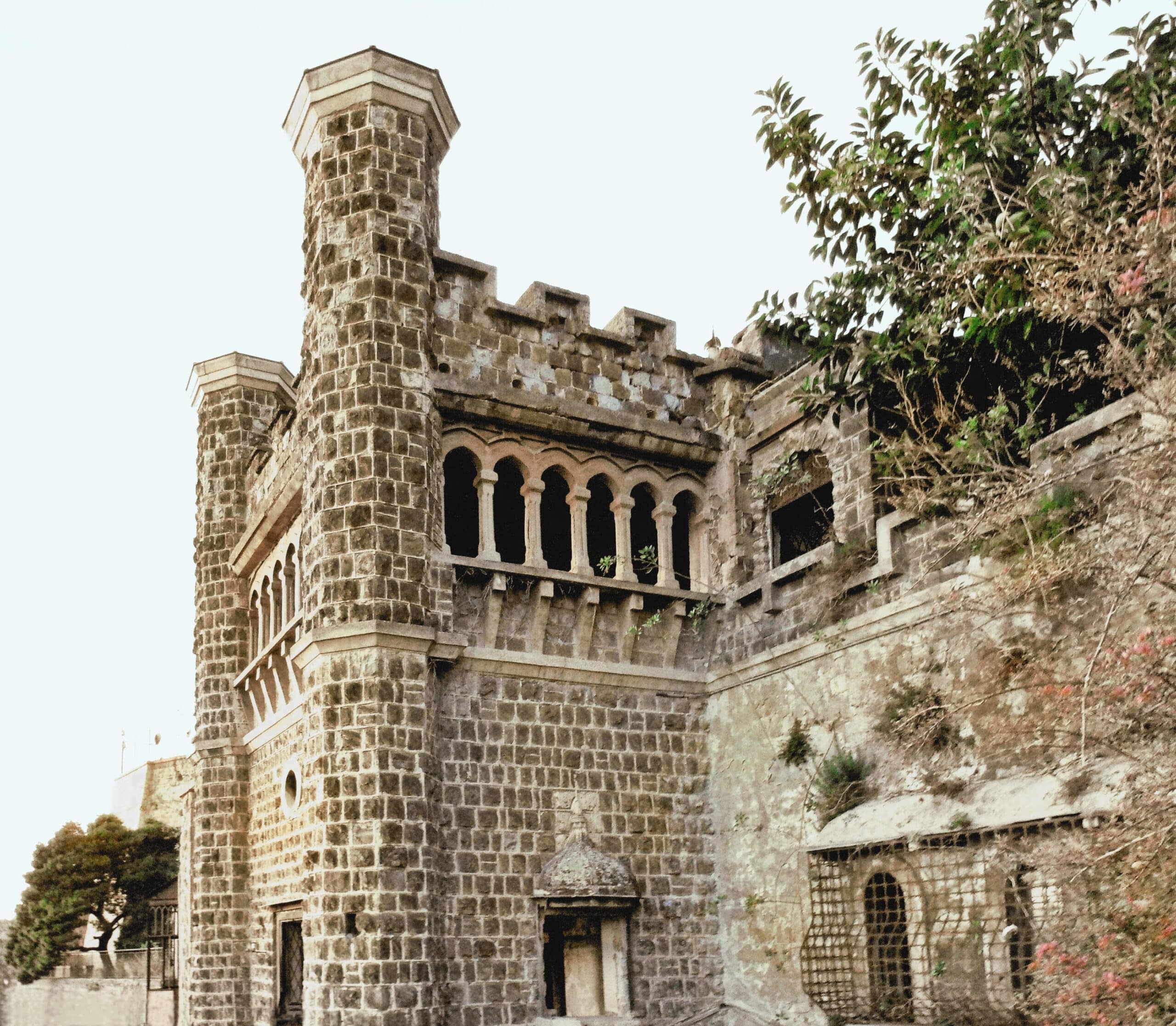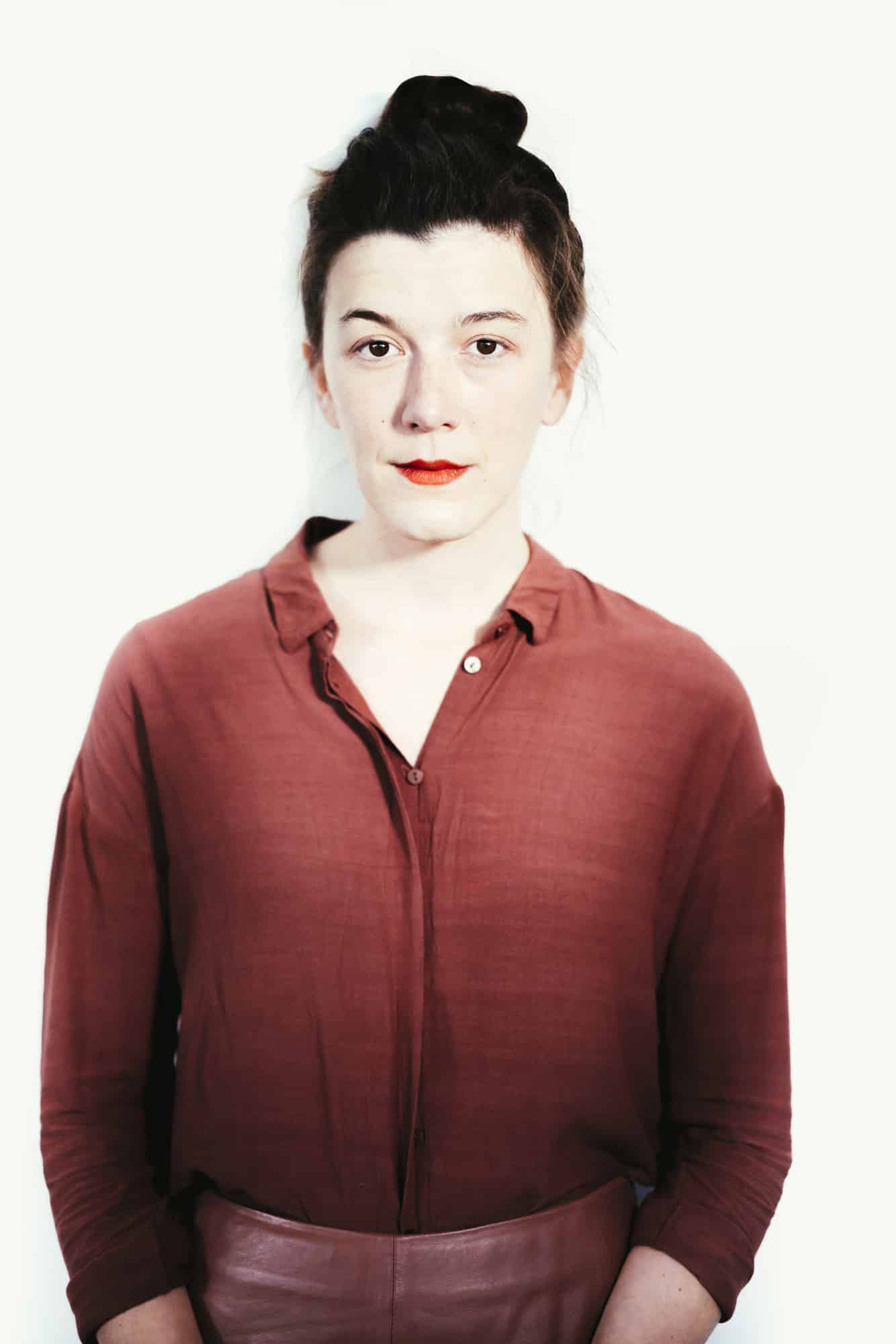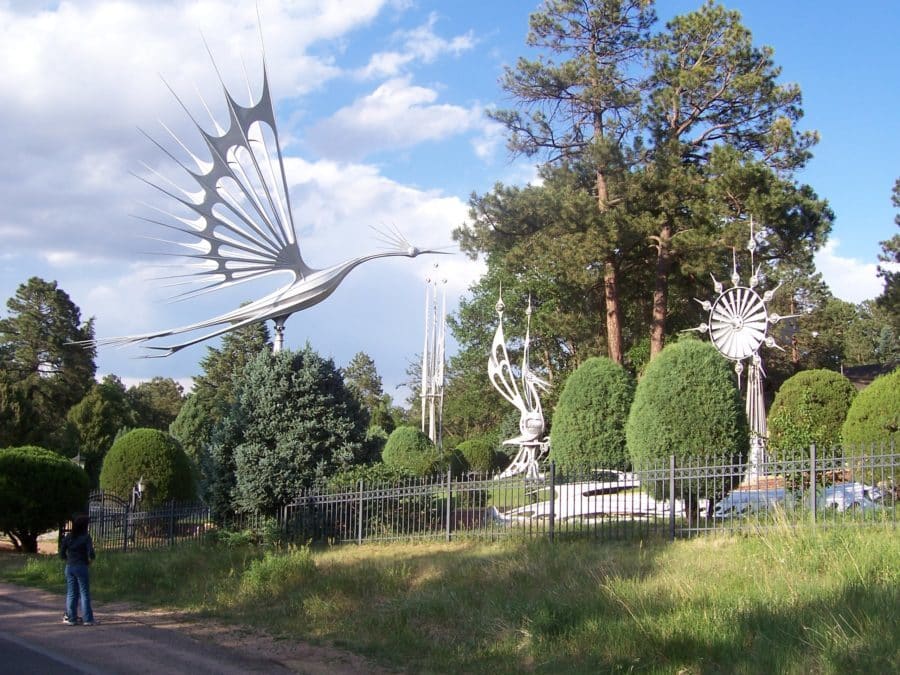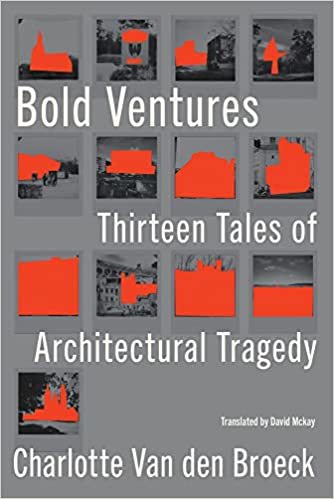Dying for Design: ‘Bold Ventures’ by Charlotte Van den Broeck
In Bold Ventures, her award-winning prose debut, Charlotte Van den Broeck tells the story of tragic architects who committed suicide in or because of the buildings they designed. Van den Broeck boldly searches for a depth rarely encountered nowadays, one necessary for calling yourself an artist.
‘It’s not normal for a young woman to be so obsessed with death. You shouldn’t be coming up with books, you should see a psychiatrist.’ Giulia, a fiery Neapolitan in her early fifties, doesn’t get it, the fascination of the young Flemish writer for the dilapidated Villa Ebe, a house designed by Scottish-American architect Lamont Young, who committed suicide there in 1929 at the age of seventy-eight. Surely it’s no more than a dreary ruin? There are far more beautiful sites elsewhere in the city!
 Villa Ebe in Naples, designed by Scottish-American architect Lamont Young
Villa Ebe in Naples, designed by Scottish-American architect Lamont Young© Wikimedia Commons
Nevertheless, the Flemish writer who lured Guilia to Young’s strange city palace has come to Naples especially for this. Villa Ebe is one of thirteen buildings that Charlotte Van den Broeck (born in 1991) visits in Bold Ventures, her first prose work after the well-received poetry collections Chameleon (2015) and Nachtroer (2017). In the book, she visits thirteen “bold ventures” in Europe and the United States, designed by architects who committed suicide – or who are said to have done so, even if it’s not actually the case. A story like that makes the buildings more exciting, and charges them with significance.
In explaining how her fascination arose, she begins close to home, in her birthplace of Turnhout. The municipal swimming pool opened in 2005, but was permanently closed six years later, because design faults led to its being more often closed than open. Shortly afterwards there were whispers that the architect, whose name mysteriously remains unknown even today, had killed himself. No one knows if it’s true, but the act would fit so well with the failed building that it’s too good not to believe. Four other architects in Bold Ventures met the same fate.
 Charlotte Van den Broeck
Charlotte Van den BroeckMore fundamental to Van den Broeck’s research are the seven buildings by architects who really did commit suicide: for them the gap between dream and reality, familiar to both architect and writer, turned out to be so unbridgeable that it was unbearable to continue living. Nearest to home is the P.T.T./R.T.T.-building by Gaston Eysselinck in Ostend, his first public commission and last grand design (1954). Following various twists in finishing the building and the death of a loved one, the architect gassed himself shortly after completion in his apartment a little way away. The suicide of the Neapolitan utopian Lamont Young, thirty-two years earlier in his Villa Ebe, was not directly related to tensions or construction faults, but to what is possibly the worst thing that can happen to an artist: he was ignored, forgotten.
Art history can be harsh, as Eduard von der Nüll and August Sicard von Sicardsburg were also aware. The architect duo were derided in the press after the completion of their Vienna State Opera in 1869, which soon drove Von der Nüll to suicide; Sicard died not long afterwards in destitution. And what can we say of the American architect Reginald Wycliffe Geare? In 1922 a snowstorm caused his Knickerbocker Theatre in Washington DC to fall down. There were ninety-five deaths and around a hundred injuries. Investigations pointed to a construction fault. Geare became mentally exhausted by the subsequent trial. Five years after the collapse he gassed himself.
 The collapsed Knickerbocker Theatre, a design by American architect Reginald Wycliffe Geare
The collapsed Knickerbocker Theatre, a design by American architect Reginald Wycliffe Geare© Library of Congress
The final location Van den Broeck handles is also the farthest distant. In Colorado Springs she visits Kempf’s Kinetic Sculpture Garden. The artist and architect Starr Gideon Kempf apparently had an unbearably contrary character. ‘When he was told he couldn’t do something, he went off and did it. Just like that, to see how it would turn out.’ He designed his own house with low ceilings, so that his modest stature was not too obvious. In the garden he placed enormous kinetic statues in metal, on which he worked manically. In 1995 he became aware that his body was growing too old to continue in that way. He shot himself in the head in his studio, leaving his last sculpture Untitled unfinished.
The architect who commits suicide: it’s no coincidence that a writer has picked that particular topic for a first book. Like an architect, a writer builds a world according to his or her insights, entirely in the manner he or she has envisaged. Just as it is a life’s work for an architect to make something that completely fulfils their vision, so the writer strives to write precisely what they want to say in the ultimate book, nothing more, but more importantly nothing less. The almost absurd intensity with which both kinds of artist immerse themselves in the realisation of fantasies, in effecting castles in the air, betrays an immense need to be seen, affirmed, admired – otherwise the diligence and monomania you pour into your Sisyphean task threatens to be unmasked as a delusion.
If admiration is not forthcoming, or if the realisation turns out to be less perfect than the vision, that leads to a dangerous, fundamental existential crisis: what have they lived for then? Why did they spend all that time ignoring real, tangible life? Can you create art at all if you don’t risk everything, including yourself and your own life? Where do you find the decisiveness, the courage, the persistence needed, the faith to even begin and then keep going? Would art be made if people resigned themselves to the relativity of every human achievement? Is it not precisely the refusal to do so which leads to art?
 Kempf’s Kinetic Sculpture Garden in Colorado Springs
Kempf’s Kinetic Sculpture Garden in Colorado SpringsIn that sense the buildings Van den Broeck visits really are “bold ventures”, refusals, realisations which, almost against your better judgement, you risk, in order to make something immortal of yourself, to leave something behind, to give purpose to what starts out as pointless. Van den Broeck is eminently aware that her book, too, is a bold venture – it is with good reason that she thanks her friends at the back of the book for ‘sticking close to me as I explored this dangerous topic’. For even as the book is disguised as a chain of travel stories, in fact it is an exploration of the self – a cautious self-investigation which probes rather than making claims, which indicates the depths, without entirely daring to seek them out, out of fear of what lies locked up in those depths.
At the same time she knows it herself too: she admires ‘Kempf’s irresponsible approach to life’; she talks about her ‘own heaviness, how intense it can be sometimes’, her ‘petty, despotic urge’, identifies her longing for ‘perfection’ and ‘the unattainable’: ‘if I can’t have it, I want it, with a reckless desire, heedless of consequences.’ But fully unravelling that side of herself is a bridge too far (for now?), the fear is still too great. It’s possible in the mirror of another person. It’s her boyfriend who uses the word ‘compulsive’ to describe her behaviour. It is his words which she reproduces when she poses the question which also arises in the head of the attentive reader: ‘Were you right? In the suicides of these architects, am I searching for false idols, forerunners, allies, to push me to a similar end when total failure hits me? Are you scared I’ll let things go too far?’
Van den Broeck plays a risky game in Bold Ventures, but perhaps not quite risky enough. Van den Broeck gives and takes, says A, but is far too quiet about B, reveals herself slightly then withdraws – behind the anecdotes of the travel story, behind the stories about works of art, behind the stories of those architects. She seems to be whispering: ‘I’m at stake here, be careful,’ yet seems startled by the whisper. There’s no shame in that: an abyss can be extremely deep, her stories themselves show how risky it is to put yourself entirely at stake in your work. Nevertheless in my view that is the path she must follow in her future writing.
The fact that she is aware of this herself becomes clear from her visit to a second hand book shop in Washington. She seeks out the book Oranges by the non-fiction author John McPhee (1931), with the intention of learning from him ‘how to be less present in the book I’m trying to write’. With gentle admiration she sketches his strengths: ‘He lends you his eyes and his mind, observes the object of his writing, absorbs the experience, and somehow expresses it as a set of irresistible conclusions. And all this with a bare minimum of narrative intervention.’
That is precisely the path I would like to see Van den Broeck tread in her next prose work. Putting yourself at stake without making yourself the focus of attention – perhaps that is the trick for coming as close as possible to the perfect work you have in mind. It’s not writing about yourself that is the way to be openly, honestly yourself, but the opposite: completely writing yourself away – she already achieves this a couple of times in this book, mainly in wonderful descriptions of nature. It is not the way in which you talk about yourself that determines who you are, but the things you see and the way you see them, what attracts your attention, what you focus on – and what you leave out of the picture. It is not the distortion of reality, making explicit your wishes and desires, but the selection of what to show.
 The British edition of 'Bold Ventures'
The British edition of 'Bold Ventures'I therefore believe that Bold Ventures would have been even stronger if Van den Broeck had not written it in the form of a series of travel stories, but if she had put herself in the place of one of the architects – and herself crept into their skin and mind to tell her own (fictionalised) story in her own way. In that way as a narrator/speaker she could coincide completely with the artist who experiences the failure. That too is a dangerous intervention, perhaps even more dangerous than the exploration she has done – but perhaps in doing so it would be even more authentic, and still more convincing to the reader.
Nevertheless Van den Broeck can rest easy. Bold Ventures is no failure nor a mediocre book. It is honest in its struggle, dares to seek out a depth rarely encountered nowadays, one necessary for calling yourself an artist. It is the perfect book at this moment in her still young writer’s career: there is enough in it to convince the reader that this writer has something very special, and at the same time some aspects of the book could be better, so there is room for growth.
I’ll mention two: firstly the way she sometimes more or less randomly throws in a quotation from her reading is somewhat abrupt and clumsy; secondly the passages with factual historical descriptions of events and buildings are a little dull and encyclopaedic; both put the reader in mind of an academic paper.
 The American edition of 'Bold Ventures'
The American edition of 'Bold Ventures'A great shortcoming, however, not to be blamed on the writer but on her editor or publisher, is the haste with which the manuscript appears to have been rushed to the printer. This has resulted in a number of typos remaining in the text, and even one factual error (albeit not a very important one: the ‘sublime Art Deco pool’ in Ghent is not at the Baudelokaai but in Veermanplein, although any Ghent resident will still know which swimming pool she’s talking about).
These are irritating afterthoughts in this first prose book by a writer who has everything it takes to grow into the very best version of herself – one who dares to risk everything, who dares to dissolve completely into that which she is looking at and in the act of looking to show who she is herself, as she does in Bold Ventures when she stands before L.S. Lowry’s The Sea in Glasgow, the hazy seascape that adorns the Dutch edition of her book. As long as Charlotte Van den Broeck does that, dear Giulia, she has no need whatsoever of a psychiatrist.
Charlotte Van den Broeck, Bold Ventures, Chatto & Windus, London, 2022, 304 pp.
Charlotte Van den Broeck, Bold Ventures, Other Press, New York, 2022, 320 pp.
(translated from the Dutch by David McKay)












